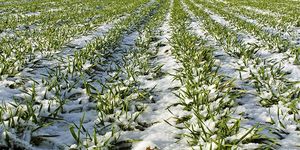Cool, Wet Spring Delays Winter Wheat Development and Fieldwork
 The winter wheat crop is sleeping in this year — and who can blame it?
The winter wheat crop is sleeping in this year — and who can blame it?
“Since the first of March, at 2-inch soil depths, we’re running 10 degrees below normal,” said Kansas State University Extension agronomist Jeanne Falk Jones. “Instead of soil temps being 40 to 42 degrees, they’re still sitting below freezing in many cases, around 30 to 32 degrees.”
As a result, a lot of winter wheat in western and northern Kansas is still lying dormant. Farther south, Oklahoma wheat is just starting to green up, and some producers are only now pulling cattle out of their grazed wheat fields, said Jeff Edwards, a crop scientist with Oklahoma State University.
The cool, wet, delayed spring comes at a time when many producers are already facing a time crunch to make up for missed fieldwork during the soggy fall of 2018. In central Kansas, Kyle Krier’s wheat fields have soaked in roughly 10 inches of rain this winter — about 9 inches above normal, he noted.
“I’m not going to say it’s a huge curse, but it’s yet to be seen if it’s a blessing,” he said. “We still have topdressing to do, alfalfa to spray and row crops to plant. It would be nice if we could get on that soon.”
A TALE OF TWO WHEAT CROPS
In Kansas, most wheat growers found themselves with only two narrow planting windows in 2018 — late September or late October into early November. Early planted wheat is doing pretty well, Krier noted. The plants are greening up and brimming with tillers, ready to deliver heads of wheat. But the late-planted fields are struggling.
“The fields we planted late didn’t emerge until December and January,” Krier said. “And there’s just one leaf sticking up right now.”
Those fields, which Kansas State wheat and forages Extension specialist Romulo Lollato estimated could account for up to 50% of the state’s wheat crop, have a lot catching up to do this spring.
“It really puts pressure on the wheat plant to rely on spring tillers to make up for the lack of fall tillers,” Falk Jones said. “And that will create a little bit of a time crunch, because the spring tillers we are relying on are supported pretty strongly by topdressing nitrogen.”
Depending on when they planted and how their fields weathered the winter’s temperature swings, some growers should evaluate stands before turning to fertilizer and weed control, Falk Jones said. Since many of the cold snaps coincided with snow cover, winterkill might be less prevalent than some expect, but spotty stands from poor fall emergence are not uncommon.
“If you’re curious how wheat is going to green up, go out and dig some plants,” she urged growers. “Cut the green off the top, warm it up, put it in water and see what kind of regrowth you get in five to seven days.”
For help deciding whether to keep or abandon a poor wheat stand, see this article from the University of Missouri: https://ipm.missouri.edu/…
SPRING FIELDWORK PRIORITIES
In a rare turn for Southern Great Plains, young wheat roots will likely find plenty of water in the root zone in the coming weeks, Falk Jones and Edwards noted. “We’ve got slow growth and emergence, but I do think once we hit that first 60- to 70-degree day, it might grow 6 inches,” Krier said. “There is just so much soil moisture.”
Topdressing wheat with nitrogen should be priority No. 1 for most wheat growers, Falk Jones said. “We want nitrogen in that root zone before our wheat starts to joint and the growing point moves above the soil surface,” she explained. “When the growing point starts to move up and form the stem, the total number of kernels on that wheat head are set. So you want to maximize the amount of nitrogen that’s there at that point.”
Even growers who applied fall fertilizer should not rest on their laurels, Krier added. He will be pulling soil samples in the days ahead to see how his fall-applied nitrogen held up after the winter’s abundant moisture. “I’m worried about how much leaching we’ve had since the fall,” he said. “We go in and put on 10% to 30% of our nitrogen in the fall. Usually, it does hold until spring, but usually we don’t have 10 inches of moisture, either.”
Growers who are pressed for time should prioritize which fields most need well-timed nitrogen and maybe consider switching to an alternative nitrogen source, such as broadcasting dry urea, if their usual set-up is more time-consuming, Falk Jones added.
For more details on nitrogen decision-making for wheat, see this Kansas State University article: https://webapp.agron.ksu.edu/…
WHAT TO WATCH FOR
If conditions stay wet in the months to come, Krier expects fungal diseases will thrive in wheat. Leaf rust was increasing and spreading across southern and central Texas as early as mid-to-late January, so growers should be on alert for that and stripe rust this year, cautioned Bob Hunger, a Oklahoma State University plant pathologist, in his monthly disease update.
Falk Jones wants growers to keep an eye on wheat streak mosaic virus this spring, as well. Summer hailstorms last year produced a lot of volunteer wheat, which thrived during the wet fall months. But temperatures stayed cool, too, which can discourage reproduction and development of the wheat curl mite, which spreads the disease and survives on volunteer wheat, she added.
“We do have both volunteer wheat and curl mites around, so Mother Nature will be in charge of what happens here,” she said. “We would need a prolonged warm period this spring for them to spread.”
See more information on wheat streak mosaic virus here: http://kswheat.com/…
Emily Unglesbee can be reached at Emily.unglesbee@dtn.com
Follow her on Twitter @Emily_Unglesbee
Source: Emily Unglesbee, DTN
